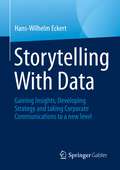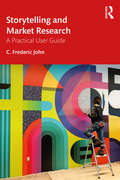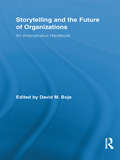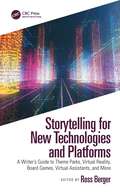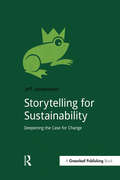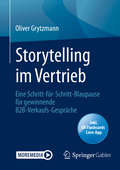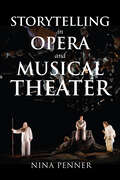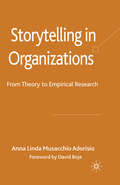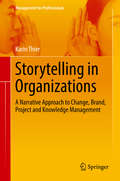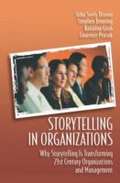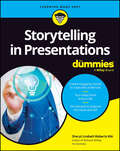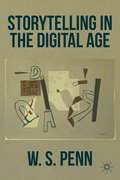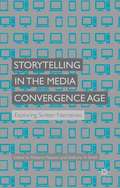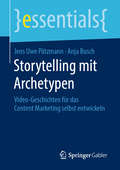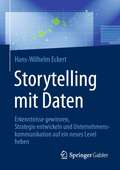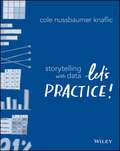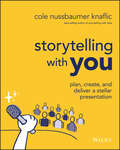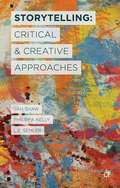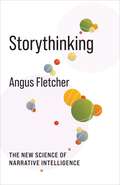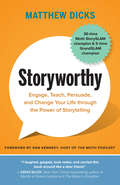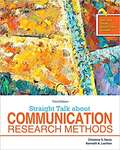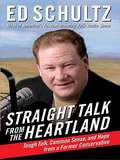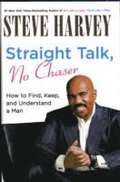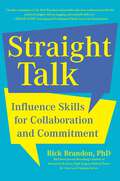- Table View
- List View
Storytelling With Data: Gaining Insights, Developing Strategy and taking Corporate Communications to a new level
by Hans-Wilhelm EckertThis book shows the role data plays in communication and marketing and how it can be used as an important source for storytelling. Because data, as a raw material of the digital age, inspires corporate strategy. Provided it is collected, interpreted and processed properly, it provides new and sometimes surprising insights into contexts and offers the opportunity to develop exciting stories from it. Stories that also create relevance with regard to corporate goals, spark dialogues and make communication effective. The author explains in an easy-to-understand way how data-based communication strategies can be turned into gripping stories. He also provides useful tools and shows why data can lie, how important its visual processing is, where its use meets ethical limits and why data protection is also a business opportunity. Using practical examples, the book offers marketing and communication experts - but also interested managers from other disciplines - numerous inspirations and new perspectives.
Storytelling and Market Research: A Practical User Guide
by C. Frederic JohnShowing how market researchers can get a seat at the decision-making table, this book is the essential guide to mastering storytelling techniques that can dramatically enhance the impact of research reports and presentations, commanding full audience engagement and buy-in. While demand for storytelling in marketing research reports and presentations has mushroomed in recent years, there can be confusion about what decision-makers mean by "stories." Leading market research expert C. Frederic John eliminates this confusion by defining four specific types of story in the business arena, and providing a series of "how-to" guides for generating effective solutions when communicating learning and other information. This book is the first to emphasize the needs of the report reader or presentation audience. Drawing on examples from ancient and modern literature, drama, opera, and other arts, this book will help today’s (and tomorrow’s) market research professionals to thrive in a world demanding insights, real-world recommendations, and more relevant deliverables.
Storytelling and the Future of Organizations: An Antenarrative Handbook (Routledge Studies in Management, Organizations and Society)
by David M. BojeStorytelling is part of social action and interaction that actually shapes the future of organizations. Organization and management studies have overwhelmingly focused to date on rational narrative structures with beginnings, middles, and ends, where narrative has proved to be a handy concept in qualitative studies. Far less attention is given however to the more spontaneous and ‘non-staged’ storytelling that occurs in organizations. Storytelling and the Future of Organizations explores the science and practice of ‘antenarrative’ because that is how the future of organization is shaped. Antenarrative is a term invented by David M. Boje in 2001, and is defined as a ‘bet on the future,’ as ‘before’ narrative linearity, coherence, and stability sets in. Antenarrative is all about ’prospective sensemaking,’ betting on the future before narrative retrospection fossilizes the past. Antenarrative storytelling is therefore agential in ways that traditional narratology has yet to come to grips with. This handbook contribution is bringing together a decade of scholarship on ‘antenarrative.’ It is the first volume to offer such a varied but systematic examination of non-traditional narrative inquiry in the management realm, organizing and developing its approach, and providing new insights for management students and scholars.
Storytelling for New Technologies and Platforms: A Writer’s Guide to Theme Parks, Virtual Reality, Board Games, Virtual Assistants, and More
by Ross BergerWant to know what it’s like to write for a theme park attraction? Or an interactive toy? Or for a virtual reality game? Wait – those tell stories? And there are jobs for people to write them? Thanks to technology, interactive products and live experiences can now engage us with memorable characters and exciting adventures that were once only destined for the cinema. Storytelling for New Technologies and Platforms: A Writer’s Guide to Theme Parks, Virtual Reality, Board Games, Virtual Assistants, and More is a handbook for writers, students, producers, teachers, scholars, career changers, early tech adopters, and just about anyone who loves story and technology. As a collection of articles from some of the best creative writers in their medium, this book will prepare content creators of tomorrow to tackle some of today's most exhilarating creative challenges found on a screen ... or off! Key Features: Expert advice from several industry professionals who have worked for some of the world’s biggest tech and interactive companies. Best practices that not only guide writers on how to apply their craft to new fields, but also prepare them for the common ambiguity they will find in corporate and start-up environments. Breakdown of platforms that shows how tech capabilities can fulfill content expectations and how content can fulfill tech expectations. Basic storytelling mechanics customized to today’s popular technologies, live experiences, and traditional game platforms.
Storytelling for Sustainability: Deepening the Case for Change
by Jeff LeinaweaverStorytelling is an ancient practice and a priceless skill. For sustainability practitioners who want to be more strategic and have more influence in shaping a better world, it is a crucial skill to master.In this short guide, veteran sustainability strategist and storyteller Jeff Leinaweaver shows you which ways of storytelling "transmit resonance" and lead to success and which lead to failure.You will learn techniques for using storytelling to attract attention and get better results, whether you are communicating statistics and priorities, advocating for change, organizing stakeholders, or building an authentic brand and community.Storytelling for Sustainability offers a comprehensive primer on storytelling and a range of insights and practical exercises, including: the failure of the sustainability story, discovering your passionate fact, your convenience story, reverse storyboarding, and what’s my storyline?
Storytelling im Vertrieb: Eine Schritt-für-Schritt-Blaupause für gewinnende B2B-Verkaufs-Gespräche
by Oliver GrytzmannWie Sie als Vertriebler mit der richtigen Story und den passenden Bildern zum Vertragsabschluss kommen, erfahren Sie in diesem Praxis-Ratgeber. Für Vertriebler wie Sie hat Oliver Grytzmann diese Schritt-für-Schritt-Anleitung geschrieben. In „Storytelling im Vertrieb“ zeigt er Ihnen an zahlreichen Beispielen, wie Sie mit Storytelling klare mentale Bilder in die Köpfe der Entscheider setzen – bei Außendienst-Einsätzen, Entscheider- und Einkaufsgremien, Vorträgen vor Fachpublikum und bei einem Pitch. Mithilfe dieser mentalen Bilder verstehen Entscheider Ihr Produkt bzw. Ihre Dienstleistung schneller und besser, weil Bilder im Kopf hängen bleiben und Entscheider zu einer Story viel leichter eine emotionale Bindung aufbauen. Drei Vorteile, mit denen Sie als Vertriebler zum Vertragsabschluss kommen. Lernen und erleben Sie: Aus welchen Grundelementen ein mentales Bild besteht.Wie die Struktur einer guten Vertriebs-Story aussieht.Wie Sie diese Struktur in packende Worte fassen können.Welche alternativen Formen des Vertriebs-Storytelling es gibt.Konkrete Anleitungen, wie Sie bereits mit Ihrem Auftreten eine Story erzählen.
Storytelling in Opera and Musical Theater (Musical Meaning and Interpretation)
by Nina PennerStorytelling in Opera and Musical Theater is the first systematic exploration of how sung forms of drama tell stories. Through examples from opera's origins to contemporary musicals, Nina Penner examines the roles of character-narrators and how they differ from those in literary and cinematic works, how music can orient spectators to characters' points of view, how being privy to characters' inner thoughts and feelings may evoke feelings of sympathy or empathy, and how performers' choices affect not only who is telling the story but what story is being told. Unique about Penner's approach is her engagement with current work in analytic philosophy. Her study reveals not only the resources this philosophical tradition can bring to musicology but those which musicology can bring to philosophy, challenging and refining accounts of narrative, point of view, and the work-performance relationship within both disciplines. She also considers practical problems singers and directors confront on a daily basis, such as what to do about Wagner's Jewish caricatures and the racism of Orientalist operas. More generally, Penner reflects on how centuries-old works remain meaningful to contemporary audiences and have the power to attract new, more diverse audiences to opera and musical theater. By exploring how practitioners past and present have addressed these issues, Storytelling in Opera and Musical Theater offers suggestions for how opera and musical theater can continue to entertain and enrich the lives of 21st-century audiences.
Storytelling in Organizations
by Anna Linda Musacchio AdorisioStorytelling in organizations is a notion that encompasses both the stories that the organization produces and the ones told by its members. It provides both an in-depth treatment of the literature on narratives, stories and storytelling and an extensive empirical case from an American banking institution.
Storytelling in Organizations: A New Approach To Change, Brand, Project And Knowledge Management (Management For Professionals)
by Karin Thier Markus RussinThis book highlights storytelling as a concrete and viable method which can be used in various operational fields in organizations: from change management to project management and knowledge management, it presents employees’ stories on past projects and the diverse, essential aspects of corporate culture they reveal, in an easy-to-comprehend and entertaining fashion. These stories focus on specific but generic experiences which can be adapted and exploited by the reader to ultimately tap into hidden knowledge and increase transparency during daily routines in his or her own organization. Knowledge managers, coaches, and strategists alike will find a 'real-life' connection through these stories, helping them improve their own storytelling methods. The book also provides exhaustive information on the latest storytelling methods and strategies.The adaptations Thier has made to bring learning histories to corporate settings accelerates the capture, flow, and application of organizational knowledge that speeds up changes to improve operations!George Roth (Principal Research Associate at MIT Sloan School of Management, Boston, United States)
Storytelling in Organizations: Why Storytelling Is Transforming 21st Century Organizations and Management
by John Seely Brown Stephen Denning Katalina Groh Laurence Prusak"Storytelling in Organizations" studies how four busy executives found themselves using storytelling to understanding and managing organizations. The authors describe their own experiences working on knowledge management, change management, and innovation strategies in such organizations as Xerox, the World Bank, and IBM.
Storytelling in Presentations For Dummies
by Sheryl Lindsell-RobertsLearn to influence audiences with storyopia: Stories that take them on a journey from what is to what could be: Storytelling in Presentations For Dummies shows you how to develop and deliver a presentation through storytelling, keeping audience interested, and most importantly, making them heroes that take action towards change. You’ll learn how to cull stories from your own experiences, and before you know it, you’ll have more stories than Aesop has fables. You’ll learn about the latest presentation software, so you can integrate visuals into your presentations and avoid the dreaded “Death by PowerPoint.” You’ll also learn how to deal with challenging on-the-spot situations, deliver investor pitches and executive briefs, and present a paper at a conference. Additionally, find out how to deliver someone else’s content and make it your own. This book will help you level up anywhere you need to present information by mastering the art of savvy presentations—the most effective business communications tools of our time. Identify experiences that can be molded into stories that drive change. Prepare powerful openings to hook your audience right away whether delivering in person, online, or hybrid Have your audience get the most from your presentation with an effective call to action Prepare a storyboard, which is like a frame-by-frame roadmap, that will mesh together what you’ll show and what you’ll tell Leverage software like Canva, Prezi, and Storyboarder to tie your presentation together Enjoy the colorful 8-page mini-booklet, “Storytelling to Storyboarding”This Dummies guide is perfect for any professional who needs to present, and at some time all professionals do. It’s also for entrepreneurs who want to build community and grow their business, in addition to students who want to wow teachers and classmates.
Storytelling in Religious Education
by Susan M. ShawPart I. Foundations of storytelling in religious education Part II. Types of story in religious education Part III. Development and storytelling
Storytelling in the Digital Age
by W. S. PennThrough a professional story-teller's sometimes humorous commentary on culture and literature from The Odyssey on, Storytelling in the Digital Age suggests that literature is not an artifact to be studied but a living process. Often irreverent, crossing literary and scholarly lines, W. S. Penn aims to discover what literature does for an imaginatively engaged reader. Aimed to amuse, provoke, and propose ideas, this book makes bold new statements about what it means to be human through an interrogation of a variety of stories told and re-told over thousands of years.
Storytelling in the Media Convergence Age
by Roberta Pearson Anthony N. SmithThis collection investigates the relationship between contemporary screen narratives and their varied contexts of production, circulation and reception, exploring storytelling practices across a range of different media and national and institutional sites. While convergence and globalisation blur the boundaries between media and nations, it is still vital to account for the persistent national, medium, institutional and technological specificities that give rise to different narrative forms. The chapters study the ways in which these factors shape events, characters and settings; inform modes of narrative presentation; influence, via paratextual surround, potential interpretations; and accord certain stories more value than others. The authors use case studies drawn from a range of media, from Hollywood franchises to digital comics, and a range of countries, from United States to Japan. In connecting contemporary screen media narratives to their contexts, this book offers a new perspective on recent transformations in screen media culture.
Storytelling mit Archetypen: Video-Geschichten für das Content Marketing selbst entwickeln (essentials)
by Jens Uwe Pätzmann Anja BuschDieses essential beschreibt, wie Unternehmen mithilfe von Archetypen besonders gute Geschichten erzählen können. Der Schwerpunkt liegt auf der Kreation von Bewegtbild-Videos im Rahmen des Content Marketing. Die Autoren identifizierten im Rahmen einer Studie 15 archetypische Storytelling-Formate, die als kreative Sprungbretter für das eigene Erstellen von Storys dienen können. Zu jedem Format gibt es ein Beispiel-Video, das mit einem QR-Code abgerufen werden kann.
Storytelling mit Daten: Erkenntnisse gewinnen, Strategie entwickeln und Unternehmenskommunikation auf ein neues Level heben
by Hans-Wilhelm EckertDieses Buch zeigt, welche Rolle Daten für Kommunikation und Marketing spielen und wie sie als wichtige Quelle für das Storytelling genutzt werden können. Denn Daten beflügeln als Rohstoff des digitalen Zeitalters die Unternehmensstrategie. Sie ermöglichen – sofern sauber gesammelt, interpretiert und aufbereitet – neue und mitunter überraschende Einblicke in Zusammenhänge und bieten die Chance, daraus spannende Geschichten zu entwickeln. Geschichten, die auch im Hinblick auf Unternehmensziele Relevanz schaffen, Dialoge entfachen und die Kommunikation wirksam machen. Der Autor erklärt auf leicht verständliche Art und Weise, wie sich datenbasierte Kommunikationsstrategien in packende Storys verwandeln lassen. Zudem liefert er nützliche Tools und zeigt auf, warum Daten lügen können, wie wichtig ihre optische Aufbereitung ist, wo ihr Einsatz an ethische Grenzen stößt und warum Datenschutz auch eine unternehmerische Chance ist. Anhand von praktischen Beispielen bietet das Buch Marketing- und Kommunikationsexperten – aber auch interessierten Managern aus anderen Disziplinen – zahlreiche Inspirationen und neue Perspektiven.
Storytelling with Data: Let's Practice!
by Cole Nussbaumer KnaflicInfluence action through data! This is not a book. It is a one-of-a-kind immersive learning experience through which you can become—or teach others to be—a powerful data storyteller. Let’s practice! helps you build confidence and credibility to create graphs and visualizations that make sense and weave them into action-inspiring stories. Expanding upon best seller storytelling with data’s foundational lessons, Let’s practice! delivers fresh content, a plethora of new examples, and over 100 hands-on exercises. Author and data storytelling maven Cole Nussbaumer Knaflic guides you along the path to hone core skills and become a well-practiced data communicator. Each chapter includes: ● Practice with Cole: exercises based on real-world examples first posed for you to consider and solve, followed by detailed step-by-step illustration and explanation ● Practice on your own: thought-provoking questions and even more exercises to be assigned or worked through individually, without prescribed solutions ● Practice at work: practical guidance and hands-on exercises for applying storytelling with data lessons on the job, including instruction on when and how to solicit useful feedback and refine for greater impact The lessons and exercises found within this comprehensive guide will empower you to master—or develop in others—data storytelling skills and transition your work from acceptable to exceptional. By investing in these skills for ourselves and our teams, we can all tell inspiring and influential data stories!
Storytelling with You: Plan, Create, and Deliver a Stellar Presentation
by Cole Nussbaumer KnaflicBe heard. Change minds. Get people to act. (Inspire them to clap.) Whether presenting in a meeting, delivering a keynote on stage, or simply talking with your colleagues about your latest project, you play a critical role in how information is shared. You determine whether people engage, understand, and take action. In storytelling with you, best-selling author and world-renowned speaker Cole Nussbaumer Knaflic prepares you to develop your story and deliver it with prowess. She unlocks the secrets that have propelled her from self-described introvert to sought-after presenter, distilling lessons learned into this immensely powerful and practical guide. The journey starts by building the foundation for effective communication: gaining an understanding of your audience and message. You&’ll then learn to transform your ideas into compelling stories and illustrative content. Once the materials are set, you&’ll turn your attention inward and explore strategies to hone your delivery and communicate with confidence, preparing you for exceptional meetings and knockout presentations. Give your hard work a voice and amplify your impact by communicating in a way that makes people want to listen and respond—storytelling with you will help you do it.
Storytelling: Critical And Creative Approaches
by Jan Shaw L. E. Semler Philippa KellyThis collection uses the concept of 'story' to connect literary materials and methods of analysis to wider issues of social and political importance. Drawing on a range of texts, themes include post-colonial literatures, history in literature, old stories in contemporary contexts, and the relationship between creativity and criticism.
Storythinking: The New Science of Narrative Intelligence (No Limits)
by Angus FletcherEvery time we think ahead, we are crafting a story. Every daily plan—and every political vision, social movement, scientific hypothesis, business proposal, and technological breakthrough—starts with “what if?” Linking causes to effects, considering hypotheticals and counterfactuals, asking how other people will react: these are the essence of narrative. So why do we keep overlooking story’s importance to intelligence in favor of logic?This book explains how and why our brains think in stories. Angus Fletcher, an expert in neuroscientific approaches to narrative, identifies this capacity as “storythinking.” He demonstrates that storythinking is fundamental to what makes us human. Artificial intelligence can perform symbolic logic, rational deduction, and mathematical calculation, but it is incapable of deliberating in narrative. Drawing on new research in neuroscience and narrative theory, Fletcher explores the nature of imagination, innovation, and creativity. He provides concise answers to big questions: How does storythinking work? Why did it evolve? How can it misfire? What problems can it solve?Revealing the significance of storythinking from science to business to philosophy, this book also provides ways for readers to harness its power to script better tomorrows.
Storyworthy: Engage, Teach, Persuade, and Change Your Life through the Power of Storytelling
by Matthew DicksA five-time Moth GrandSLAM winner and bestselling novelist shows how to tell a great story — and why doing so matters. Whether we realize it or not, we are always telling stories. On a first date or job interview, at a sales presentation or therapy appointment, with family or friends, we are constantly narrating events and interpreting emotions and actions. In this compelling book, storyteller extraordinaire Matthew Dicks presents wonderfully straightforward and engaging tips and techniques for constructing, telling, and polishing stories that will hold the attention of your audience (no matter how big or small). He shows that anyone can learn to be an appealing storyteller, that everyone has something &“storyworthy&” to express, and, perhaps most important, that the act of creating and telling a tale is a powerful way of understanding and enhancing your own life.
Straight Talk About Communication Research Methods
by Christine S Davis Kenneth A LachlanResearchers are like detectives. Both are trying to find something out. Both are asking and answering questions. Both are trying to put together a puzzle to come up with a solution. In both, answering questions leads to more questions. And, in both, seeing patterns is crucial to solving the puzzle. Straight Talk about Communication Research Methods presents the foundations of research methods, the choices scholars make, and the methodological decisions driving communication scholarship to balance one’s desire to know and inquire into interesting communication questions while instilling an enthusiasm about the process! Featuring a student friendly writing style, Straight Talk about Communication Research Methods is built on adult learning theory – information is given in small chunks that build upon each other, repeating then expanding knowledge. Featuring updated information and examples, the new third edition of Straight Talk about Communication Research Methods: Is Modern! The text includes material on conducting research on, and involving, social and digital media. Is Practical! Examples of how students might use communication research methods in business and industry jobs after graduation are integrated throughout. Is Groundbreaking! The text features four chapters that summarize new qualitative research methods along with comprehensive instructions on how to conduct these research methods. Is Interactive! A seamlessly integrated enhanced learning package provides both students and instructors access to online content, interactive exercises and more.
Straight Talk from the Heartland: Tough Talk, Common Sense, and Hope from a Former Conservative
by Ed SchultzThe author transformed his political beliefs after a visit to a Salvation Army shelter and then became a popular liberal radio talk show host. Here he offers his views on international relations, freedom of the press, the federal deficit, struggling rural America, public education, trade policy, and more. He outlines what he calls the "Four Pillars of a Great Nation" as well as asserts that the current US government is run by and for the rich.
Straight Talk, No Chaser: How to Find, Keep, and Understand a Man
by Steve HarveyIn the instant number one New York Times bestseller Act Like a Lady, Think Like a Man, Steve Harvey gave millions of women around the globe insight into what men really think about love, intimacy, and commitment. In his new book he zeros in on what motivates men and provides tips on how women can use that knowledge to get more of what they need out of their relationships, whether it's more help around the house, more of the right kind of attention in the bedroom, more money in the joint bank account, or more truth when it comes to the hard questions, such as: Are you committed to building a future together? Does my success intimidate you? Have you cheated on me? In Straight Talk, No Chaser: How to Find, Keep, and Understand a Man, Steve Harvey shares information on: How to Get the Truth Out of Your Man * Tired of answers that are deceptive? Harvey lays out a three-tier, CIA-style of questioning that will leave your man no choice but to cut to the chase and deliver the truth. Dating Tips, Decade by Decade * Whether you're in your twenties and just starting to date seriously, in your thirties and feeling the tick of the biological clock, or in your forties and beyond, Steve provides insight into what a man, in each decade of his life, is looking for in a mate. How to Minimize Nagging and Maximize Harmony at Home * He said he'd cut the lawn on Saturday, and you may have been within reason to think that that meant Saturday before ten in the evening, but exploding at him is only going to ruin the mood for everyone, which means no romance. Steve shows you how to talk to your man in a way that moves him to action and keeps the peace. And there's much more, including Steve's candid answers to questions you've always wanted to ask men. Drawing on a lifetime of experience and the feedback women have shared with him in reaction to Act Like a Lady, Think Like a Man, Harvey offers wisdom on a wealth of topics relevant to both sexes today. He also gets more personal, sharing anecdotes from his own family history. Always direct, often funny, and incredibly perceptive, media personality, comedian, philanthropist, and (finally) happily married husband, Steve Harvey proves once again that he is the king of relationships.
Straight Talk: Influence Skills for Collaboration and Commitment
by Rick BrandonThe costs of faulty communication are enormous for companies. Each year, billions of dollars are lost, precious time is wasted, innovation is thwarted, and morale suffers. But sharpening influence skills can address these challenges and create huge payoffs. Collaborative and commitment-driven interaction is the key to overcoming the obstacles of ever-rising performance expectations, widespread stress, and remote work. Drawing from 35 years of performance-improvement experience, Rick Brandon, PhD, trains thousands of people to improve their results and work relationships by improving the clarity and persuasiveness of their communication. Straight Talk is his &“edu-taining&” workshop-in-a-book for anyone who wants to develop direct, empathetic, and positive communication skills that will benefit themselves, their teammates, and their companies. It&’s common sense but not always common practice to work on improving interpersonal skills in order to achieve accountability and a more productive and harmonious work climate. Straight Talk shows how thoughtful changes to communication can create a ripple effect across teams and organizations. Each chapter is packed with practical tips, simple how-to instruction, real-world examples, involvement exercises, and humor, to help readers build positive influence skills with competence and confidence. Straight Talk hones core Assertive Speaking and Empathic Listening skills, and then funnels them into step-by-step formats for six vital workplace situations: Gaining Commitments, Advising and Guiding, Recognizing, Reminding, Constructively Confronting, and Challenging Ideas. Straight Talk will empower you to make interpersonal expertise your competitive advantage.
